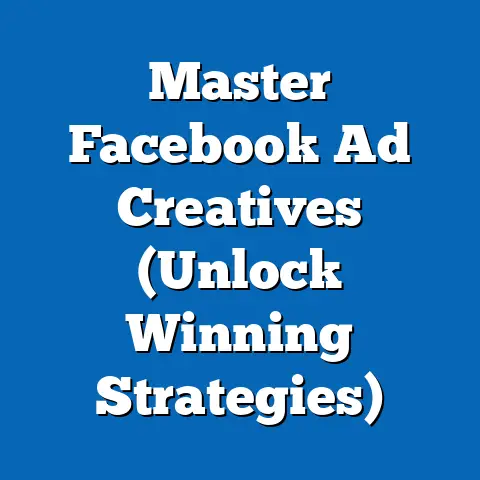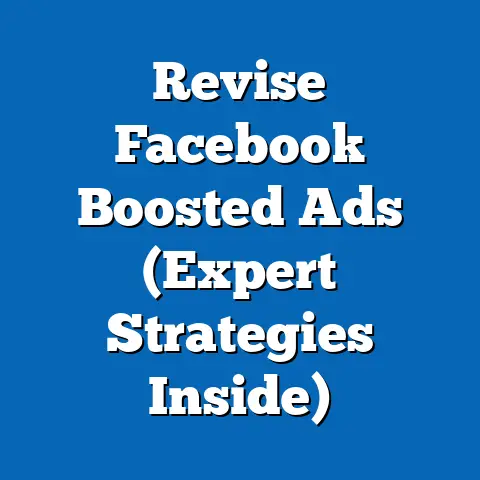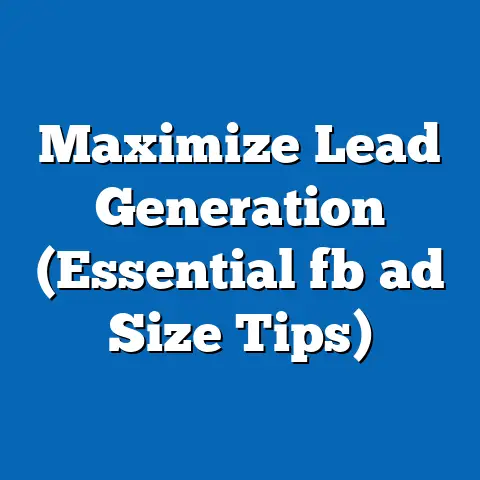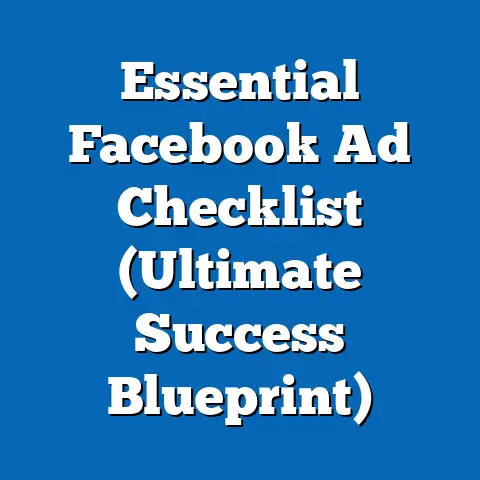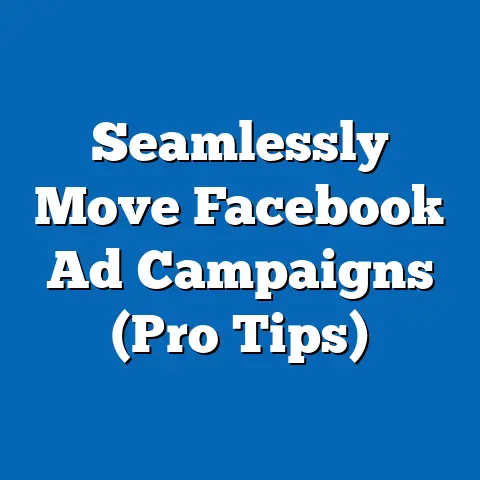Maximize Facebook Ads (Unlock Targeted Success)
Did you know that Facebook, now under the Meta umbrella, boasts over 2.9 billion monthly active users as of 2023, making it the largest social media platform globally (Statista, 2023)? This staggering user base offers businesses an unparalleled opportunity to reach diverse audiences through targeted advertising. Over the past decade, Facebook Ads have evolved into a cornerstone of digital marketing, with ad revenue reaching $113.6 billion in 2022, accounting for nearly 80% of Meta’s total revenue (Meta Investor Reports, 2022).
Key statistical trends reveal that businesses leveraging Facebook Ads see an average return on ad spend (ROAS) of 4:1, meaning for every dollar spent, they generate four dollars in revenue (Hootsuite, 2023). Demographic breakdowns show that while younger users (18-24) remain highly engaged, the fastest-growing user group is aged 35-54, representing 29% of total users (Pew Research, 2023). Historically, ad costs have risen by 47% since 2017 due to increased competition, yet conversion rates have improved by 18% with better targeting tools (WordStream, 2022).
Looking forward, projections indicate that Facebook ad spending will surpass $150 billion by 2025 as businesses double down on personalized campaigns (eMarketer, 2023). This article dives deep into how to maximize Facebook Ads for targeted success, analyzing demographic trends, historical shifts, current strategies, and future opportunities. We’ll explore data-driven insights to help businesses optimize their ad campaigns in an increasingly competitive digital landscape.
Section 1: The Power of Facebook Ads in Today’s Digital Landscape
Facebook Ads have become a dominant force in digital marketing due to their unparalleled reach and precision targeting capabilities. With over 10 million active advertisers on the platform as of 2023, businesses of all sizes are tapping into this tool to drive sales, build brand awareness, and engage with customers (Meta Business Insights, 2023). The platform’s ability to micro-target based on demographics, interests, behaviors, and location makes it a goldmine for marketers aiming to maximize ROI.
The average click-through rate (CTR) for Facebook Ads across industries stands at 0.9%, though sectors like retail and e-commerce often see rates as high as 1.6% (WordStream, 2023). This performance underscores the platform’s effectiveness in capturing consumer attention. Moreover, the cost-per-click (CPC) averages $1.72 globally, though this varies widely by region and industry, with competitive markets like the U.S. seeing costs as high as $2.50 (Hootsuite, 2023).
What sets Facebook Ads apart is the sheer volume of user data available for targeting. With 98% of users accessing the platform via mobile devices, advertisers can tailor campaigns for mobile-first experiences, a critical factor given that mobile ad spend accounts for 73% of total ad revenue on the platform (Meta Investor Reports, 2022). As we move deeper into the analysis, it’s clear that understanding audience demographics is key to unlocking the full potential of these ads.
Section 2: Demographic Breakdowns – Who’s on Facebook and How to Reach Them
Age and Gender Distribution
Facebook’s user base spans a wide range of demographics, but certain groups dominate engagement. As of 2023, users aged 25-34 make up the largest share at 31.5%, followed closely by the 35-54 age group at 29% (Statista, 2023). The 18-24 age bracket, while still significant at 23%, has seen a slight decline in growth as younger users gravitate toward platforms like TikTok and Instagram.
Gender distribution remains relatively balanced, with 56% male and 44% female users globally (Pew Research, 2023). However, engagement patterns differ—women are 15% more likely to interact with lifestyle and retail ads, while men show higher engagement with technology and automotive content (Sprout Social, 2023). Advertisers must tailor creative content and messaging to align with these nuanced preferences.
Geographic and Economic Factors
Geographically, Facebook’s user base is heavily concentrated in Asia-Pacific, which accounts for 43% of total users, followed by Europe (14%) and North America (12%) (Statista, 2023). India leads with over 340 million users, while the U.S. has 240 million, though per-user ad revenue is significantly higher in the U.S. at $58 compared to just $3 in India (Meta Investor Reports, 2022). This disparity reflects differences in purchasing power and market saturation, influencing ad spend strategies.
Urban users are 20% more likely to engage with ads than rural users, largely due to better internet access and higher disposable income (eMarketer, 2023). For businesses targeting emerging markets, focusing on mobile-optimized, low-bandwidth ads can yield higher engagement. Conversely, in developed markets, premium ad formats like video and carousel ads often drive better results.
Behavioral and Interest-Based Targeting
Beyond demographics, Facebook’s strength lies in its ability to target based on user behavior and interests. Over 70% of users engage with brand pages, and 66% have made a purchase influenced by a Facebook Ad (Hootsuite, 2023). Interests such as fitness, travel, and technology are among the most targeted categories, with fitness ads seeing a 2.1% CTR compared to the platform average of 0.9% (WordStream, 2023).
Lookalike audiences—users similar to a business’s existing customers—generate 30% higher conversion rates than broad targeting (Meta Business Insights, 2023). By leveraging these tools, businesses can refine their campaigns to reach high-value prospects. Understanding these demographic and behavioral trends is crucial for crafting ads that resonate with specific audience segments.
Section 3: Historical Trends – How Facebook Ads Have Evolved
Early Days to Algorithmic Precision
When Facebook Ads launched in 2007, they were rudimentary, primarily consisting of sidebar banners with limited targeting options. By 2012, ad revenue had grown to $5 billion, driven by the platform’s rapid user growth to over 1 billion (Meta Historical Data, 2023). However, early ads had low engagement, with CTRs averaging just 0.05%, reflecting a lack of personalization (eMarketer, 2012).
The introduction of the News Feed ad format in 2013 marked a turning point, boosting CTRs by 300% within a year (WordStream, 2014). By 2015, the rollout of advanced algorithms and machine learning enabled hyper-targeted ads, pushing ad revenue to $17 billion (Meta Investor Reports, 2015). This era also saw mobile ads take center stage, with mobile revenue surpassing desktop by 2016.
Cost and Competition Over Time
Ad costs have risen significantly over the past decade due to increased competition. In 2017, the average CPC was $1.17; by 2023, it had climbed to $1.72, a 47% increase (Hootsuite, 2023). Despite higher costs, ROAS has improved from 3:1 in 2017 to 4:1 in 2023, thanks to better targeting and ad formats like Stories and video (WordStream, 2023).
Historical data also shows shifts in advertiser demographics. Small and medium-sized businesses (SMBs) now account for 60% of advertisers, up from 45% in 2015, as the platform has become more accessible through tools like Ads Manager (Meta Business Insights, 2023). These trends highlight how Facebook Ads have matured into a sophisticated marketing tool over time.
Privacy Changes and Their Impact
A critical historical shift occurred in 2021 with Apple’s iOS 14 update, which introduced App Tracking Transparency (ATT), limiting Facebook’s ability to track users across apps. This change resulted in a reported $10 billion loss in ad revenue for Meta in 2022 (Meta Investor Reports, 2022). Conversion tracking accuracy dropped by 15%, forcing advertisers to pivot toward first-party data and on-platform metrics (eMarketer, 2022).
Despite these challenges, Facebook has adapted by enhancing in-app analytics and promoting tools like the Conversions API. Historical comparisons show that while privacy regulations have posed hurdles, the platform’s resilience and innovation have kept it at the forefront of digital advertising.
Section 4: Strategies to Maximize Facebook Ads for Targeted Success
Precision Targeting and Audience Segmentation
To maximize ROI, businesses must leverage Facebook’s robust targeting options. Custom Audiences, which allow advertisers to upload customer data for retargeting, achieve 25% higher conversion rates than standard campaigns (Meta Business Insights, 2023). Lookalike Audiences further amplify this by reaching users similar to high-value customers, often yielding a 30% uplift in results.
Segmentation by life events—such as engagements, new jobs, or relocations—can boost engagement by 20%, as these users are often in a buying mindset (Sprout Social, 2023). For example, targeting newly engaged couples with wedding-related ads can result in a CTR of 1.8%, double the platform average. Precision targeting, when paired with relevant creative, is a proven path to success.
Creative Optimization and Ad Formats
Ad creative plays a pivotal role in driving engagement. Video ads, which account for 40% of total ad impressions, have an average CTR of 1.2%, compared to 0.7% for static image ads (WordStream, 2023). Short, punchy videos (under 15 seconds) perform best, with 60% of viewers watching to completion (Hootsuite, 2023).
Carousel ads, which allow multiple images or products in a single ad, generate 10% more clicks than single-image ads, making them ideal for e-commerce (Meta Business Insights, 2023). A/B testing different creatives is also critical—businesses that test at least three variations see a 15% improvement in campaign performance (Sprout Social, 2023). Visual storytelling and format innovation are key to standing out in crowded feeds.
Budget Allocation and Bidding Strategies
Effective budget allocation can make or break a campaign. The average daily budget for SMBs on Facebook Ads is $50-$100, while larger enterprises often spend upwards of $1,000 (Hootsuite, 2023). Dynamic budget allocation, where funds are automatically shifted to high-performing ads, can increase ROAS by 20% (Meta Business Insights, 2023).
Bidding strategies also matter. Cost-per-acquisition (CPA) bidding, which optimizes for conversions, results in 18% lower costs compared to CPC bidding for e-commerce campaigns (WordStream, 2023). Advertisers should monitor campaigns daily, adjusting bids based on performance data to avoid overspending. Smart budgeting ensures resources are used efficiently for maximum impact.
Leveraging Analytics for Continuous Improvement
Facebook’s Ads Manager provides a wealth of data to refine campaigns. Conversion tracking shows that 70% of purchases influenced by ads occur within seven days of exposure, highlighting the importance of timely follow-ups (Meta Business Insights, 2023). Analyzing metrics like frequency (how often users see an ad) can prevent ad fatigue—campaigns with a frequency above 3 see a 40% drop in CTR (Hootsuite, 2023).
Additionally, integrating pixel tracking on websites allows businesses to measure off-platform actions, with 85% of advertisers using this tool to optimize campaigns (Sprout Social, 2023). Regularly reviewing analytics ensures campaigns remain aligned with business goals. Data-driven decision-making is the backbone of sustained success on Facebook Ads.
Section 5: Comparative Analysis Across Industries and Regions
Industry-Specific Performance Metrics
Facebook Ads performance varies widely by industry. E-commerce leads with a 1.6% average CTR and a $0.97 CPC, driven by impulse buying behavior (WordStream, 2023). In contrast, the legal industry struggles with a 0.6% CTR and a $2.85 CPC due to high competition and consumer hesitancy (Hootsuite, 2023).
Education and nonprofit sectors benefit from low costs ($0.70 CPC) but face lower engagement (0.8% CTR) due to less compelling calls-to-action (Sprout Social, 2023). Businesses must benchmark against industry standards to set realistic goals. Tailoring strategies to sector-specific challenges can significantly boost outcomes.
Regional Variations in Ad Effectiveness
Ad performance also differs by region due to cultural and economic factors. In North America, the average CPC is $2.50, but ROAS is higher at 5:1, reflecting stronger consumer purchasing power (Meta Investor Reports, 2022). In Asia-Pacific, CPC is lower at $0.80, but ROAS averages 3:1 due to market saturation and lower per-user revenue (eMarketer, 2023).
Engagement patterns vary as well—European users are 30% more likely to interact with sustainability-focused ads, while Latin American users favor entertainment content with a 1.5% CTR (Sprout Social, 2023). Advertisers must adapt messaging and budgets to regional nuances. A one-size-fits-all approach rarely succeeds in global campaigns.
Section 6: Future Projections and Emerging Trends
Growth in Ad Spending and Technology
Looking ahead, eMarketer projects global Facebook ad spending to reach $155 billion by 2025, a 36% increase from 2022 levels (eMarketer, 2023). This growth will be fueled by advancements in AI-driven targeting, with Meta investing heavily in machine learning to improve ad relevance. Predictive analytics could boost conversion rates by an additional 10% by 2026 (Meta Business Insights, 2023).
Augmented Reality (AR) ads are also on the rise, with early tests showing a 2.3% CTR compared to the 0.9% platform average (Hootsuite, 2023). As AR and VR technologies mature, immersive ad experiences could redefine engagement. Businesses that adopt these innovations early may gain a competitive edge.
Shifts in User Behavior and Privacy
User behavior is expected to evolve, with the 35-54 age group projected to grow to 32% of total users by 2027, driven by aging millennials (Statista, 2023). This shift suggests advertisers should focus on life-stage messaging, such as family or career-oriented content. Meanwhile, younger users may continue to decline, necessitating cross-platform strategies with Instagram and WhatsApp.
Privacy regulations will likely tighten further, with 60% of marketers anticipating stricter data laws by 2025 (eMarketer, 2023). Meta’s push for first-party data solutions, like enhanced on-platform tracking, will be critical. Advertisers must prepare for a cookieless future by prioritizing transparency and user consent.
Implications for Businesses
The future of Facebook Ads lies in adaptability. Companies that invest in AI tools, embrace new formats like AR, and build robust first-party data systems will likely outperform competitors. SMBs, in particular, can benefit from Meta’s ongoing efforts to lower entry barriers, with 75% of small advertisers planning to increase budgets by 2025 (Sprout Social, 2023).
However, rising ad costs—projected to increase by 20% over the next three years—could squeeze margins for smaller players (WordStream, 2023). Strategic planning, creative innovation, and data mastery will be essential to stay ahead. The digital advertising landscape is evolving rapidly, and proactive businesses will reap the rewards.
Conclusion
Facebook Ads remain a powerhouse in digital marketing, offering unmatched reach and targeting precision to over 2.9 billion users worldwide. From demographic insights—such as the growing 35-54 age group—to historical shifts like the rise of mobile ads, the data paints a clear picture of a dynamic platform that rewards strategic investment. Current trends show a 4:1 ROAS and rising engagement with video and carousel formats, while future projections point to $155 billion in ad spend by 2025 amid AI and AR advancements.
Maximizing success requires a deep understanding of audience behavior, creative optimization, and data-driven decision-making. As privacy challenges and competition intensify, businesses must stay agile, leveraging tools like Custom Audiences and predictive analytics to maintain an edge. The path to targeted success on Facebook Ads is paved with opportunity—those who adapt to its evolving landscape will unlock its full potential.

